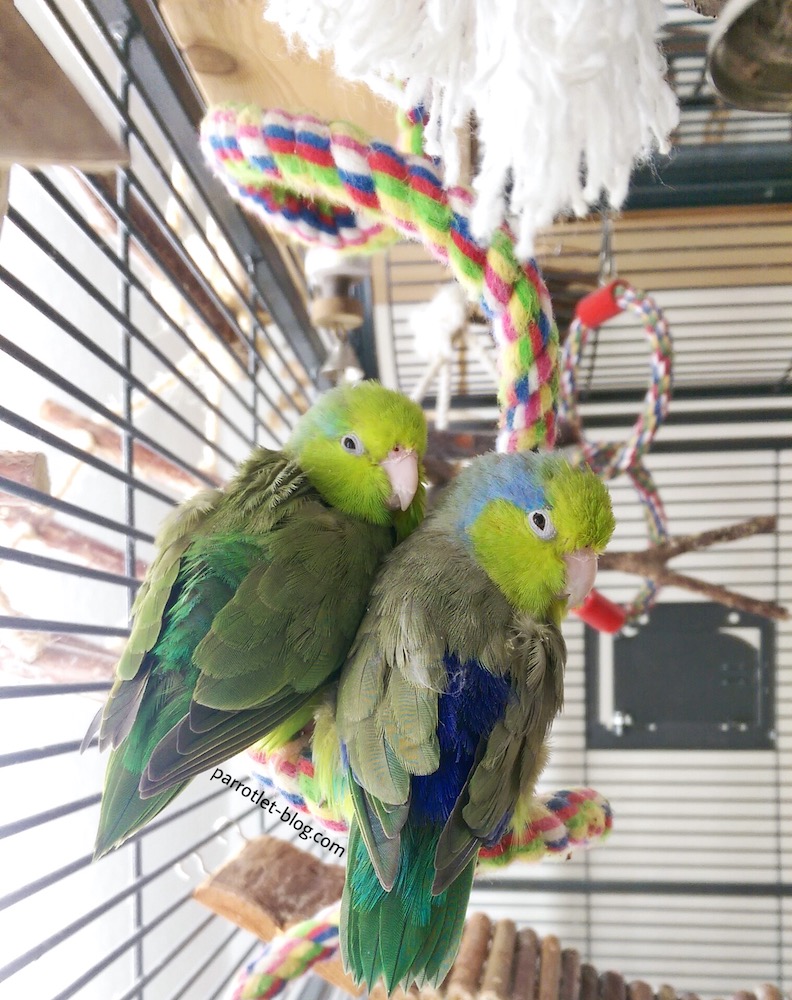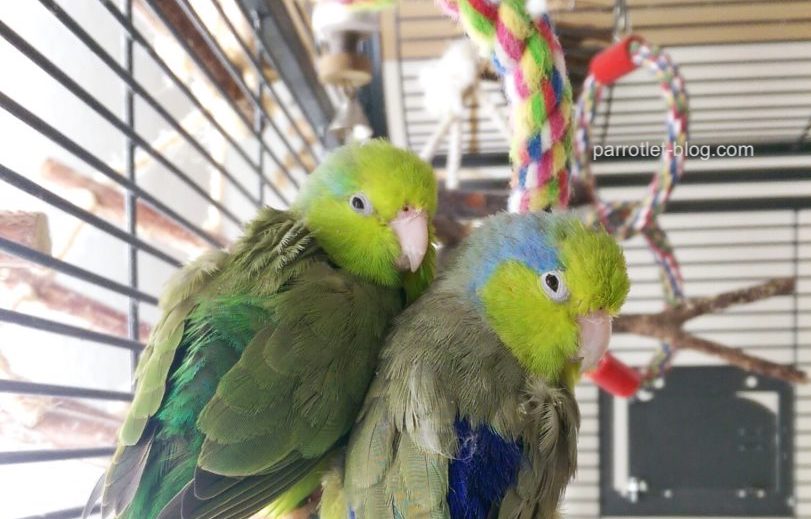A parrotlet is a small, short-tailed parrot, that belongs to the family of the Psittacidae and to the subfamily of Arinae (the “New World” or “Neotropical parrots”). To the tribus of the Arinae belong altogether approximately 150 long- and short-tailed types of parrots originally from America. Sometimes parrotlets are also called “the lovebirds of the new world”.
Parrotlet size and weight
A parrotlet is – depending on the type – at 4.7-5.9″ (12-15 cm) in lenght and weighs 0.8-1.2 oz (23-35 g). For a parrot, the parrotlet is pretty small but not the smallest parrot. Smaller are e.g. pygmy parrots with approx. 3.3-3.9″ (8.3-10 cm) and a few hanging parrots with approx. 3.9-4.7″ (10-12 cm).
Parrotlet lifespan
With good care, the lifespan of a parrotlet can be 10-15 years and in some cases even older.
Male or female parrotlet?
The basic color of the plumage of a wild-colored parrotlet is green. The male has – depending on the type – in different parts (for example, wing, head, rump) intensive blue colorations. This so-called sexual dimorphism makes it easy to distinguish a male from a female. Normally, no DNA test is required to determine the sex (except for albinos and in some cases pastel-colored parrotlets).

Parrotlet as a pet
Altogether there are eight different species of parrotlets. Of these, Pacific Parrotlets and Spectacled Parrotlets are most frequently kept as pets. Parrotlets are – with exception of the Spectacled Parrotlets – incompatible with other bird species but the small parrots must be held ALWAYS at least in pairs or in small swarms (starting from three pairs!) of their own type. With only two pairs, which are held together in one aviary, it can come to strong rivalry fights. Parrotlets are not hardy and need at least 59°F (15°C), so they should be kept indoors. In addition to a lot of free flight, parrotlets also need a large cage or aviary, which must be at least (!) 40″ (1 m) long.
Parrotlet behaviour
Parrotlets are very curious, smart, good flyers, passionate climbers and love to nibble on EVERYTHING, which is why they always need enough toys. In contrast to parakeets, the small parrots are shyer and also more aggressive. Spectacled Parrotlets are a little more peaceful than Pacific Parrotlets, who like to start a fight out of nowhere, but also get along just as quickly and cuddle with each other or preening. Parrotlets are very small, but still behave like real parrots and are usually not aware of their size. Some say therefore that parrotlets suffer from the “Big Bird syndrome”. They also try to imitate some sounds, which always makes people laugh. Some parrotlets can even say a few words. They need some time to build trust with people and they also become tame when held as a couple! Even if some of them never get tame, it is a lot of fun watching them.
Parrotlet origin and parrotlet diet in the wild
The small parrots are native from Mexico to the middle of South America. There they live together either in pairs or in (small) swarms and feed mainly on grasses, grass seeds, small berries and (cactus) fruits.
Parrotlet breeding behavior
Parrotlets become sexually mature with nine to twelve months. They are cave breeders, which means that they prefer caves for egg laying (this can also be a gap in the bookshelf!). If no cave or nesting box is provided to a couple and care is taken that the nutrition is not too rich, then there is hardly any danger that the female inadvertently starts to breed. Of course, there are always exceptions. Generally you should only breed with parrotlets when you know for sure that the animals are not siblings and have no diseases or other problems that they can pass on to the next generation. This would endanger the entire parrotelt population and ensure that in a few years there are only sick birds with a life span of just a few years.
If you like the article feel free to share it with your friends and / or write me a nice comment.
Follow the everyday adventures of my parrotlets on Instagram: parrotlet_blog.
